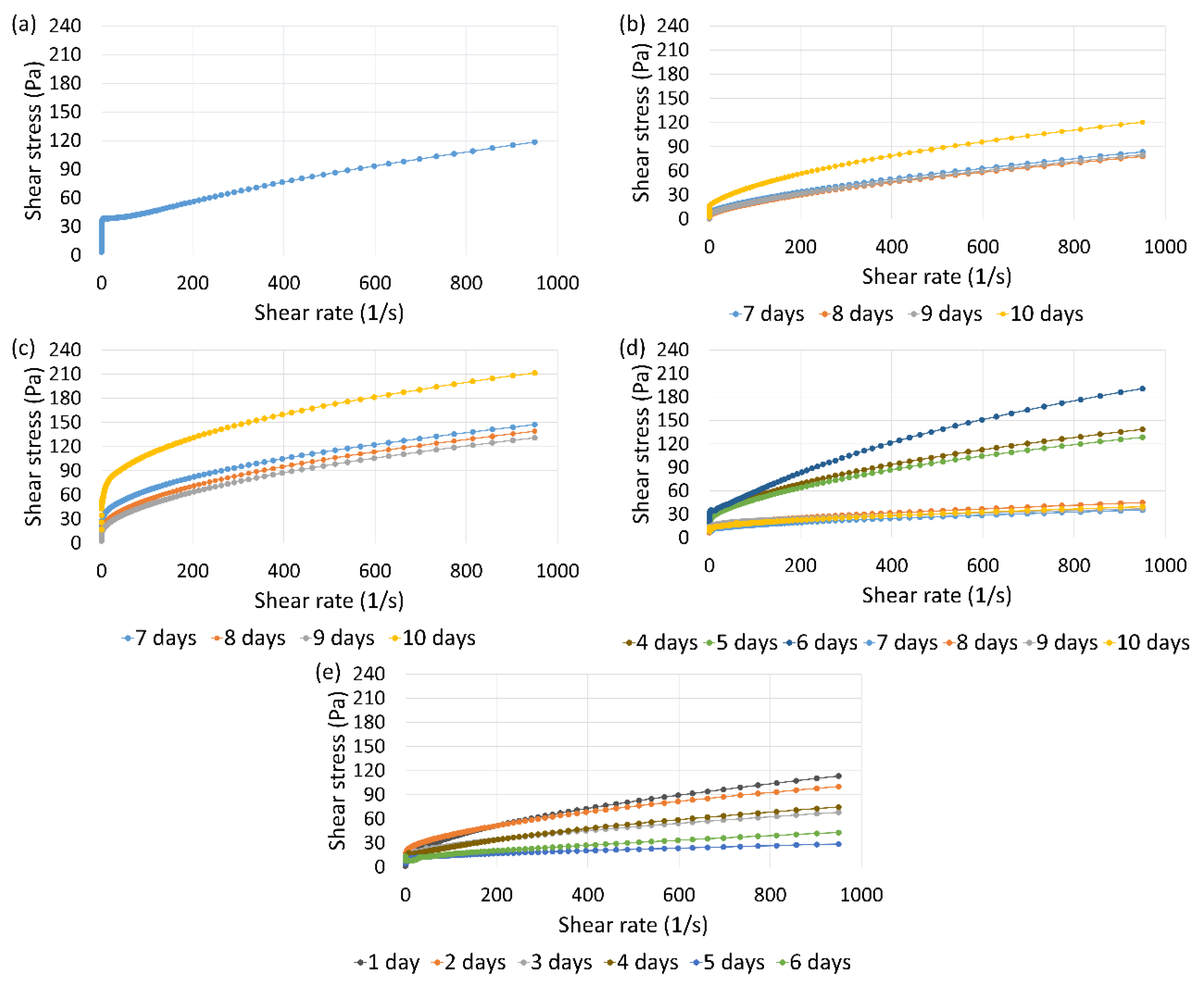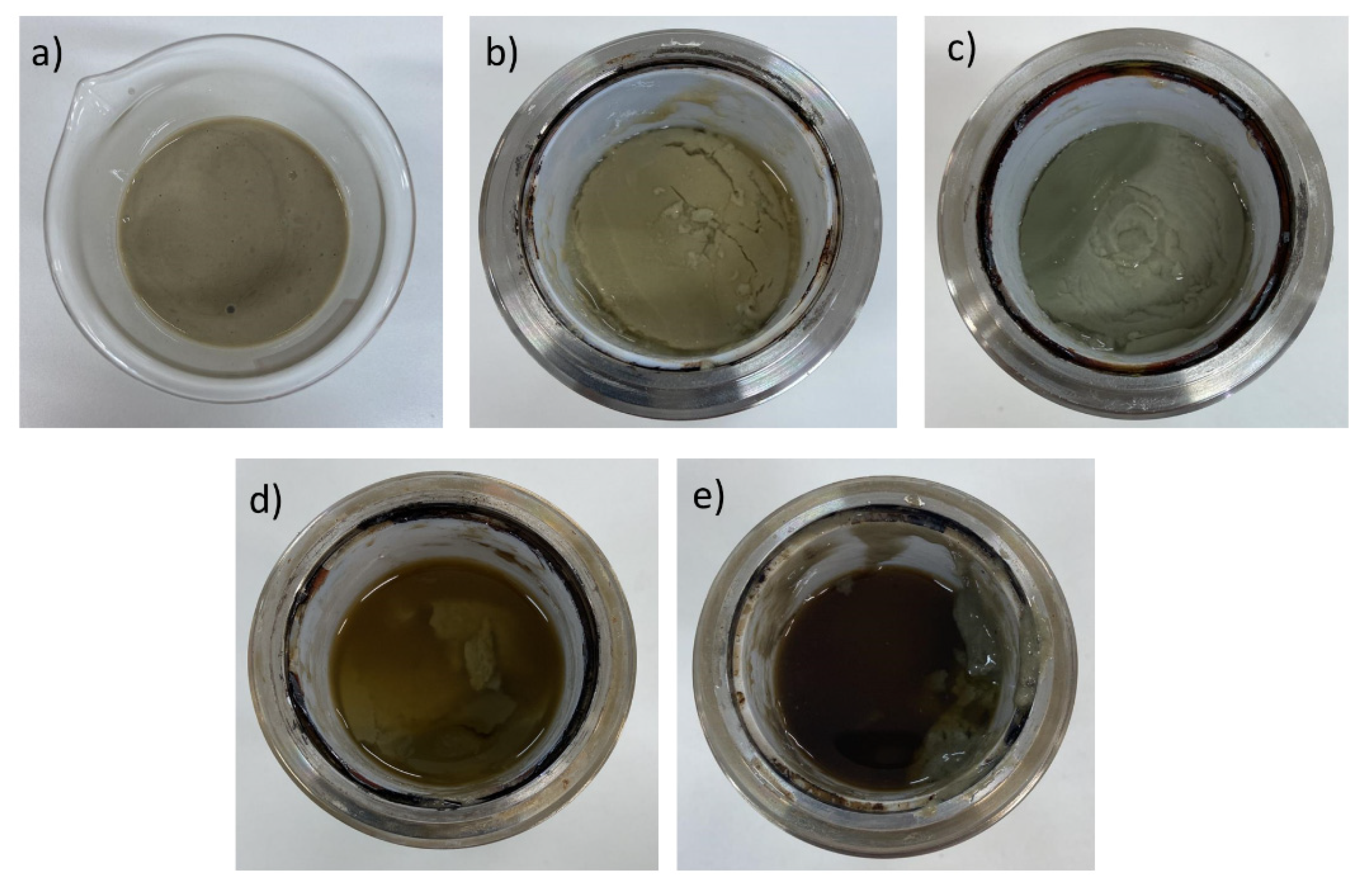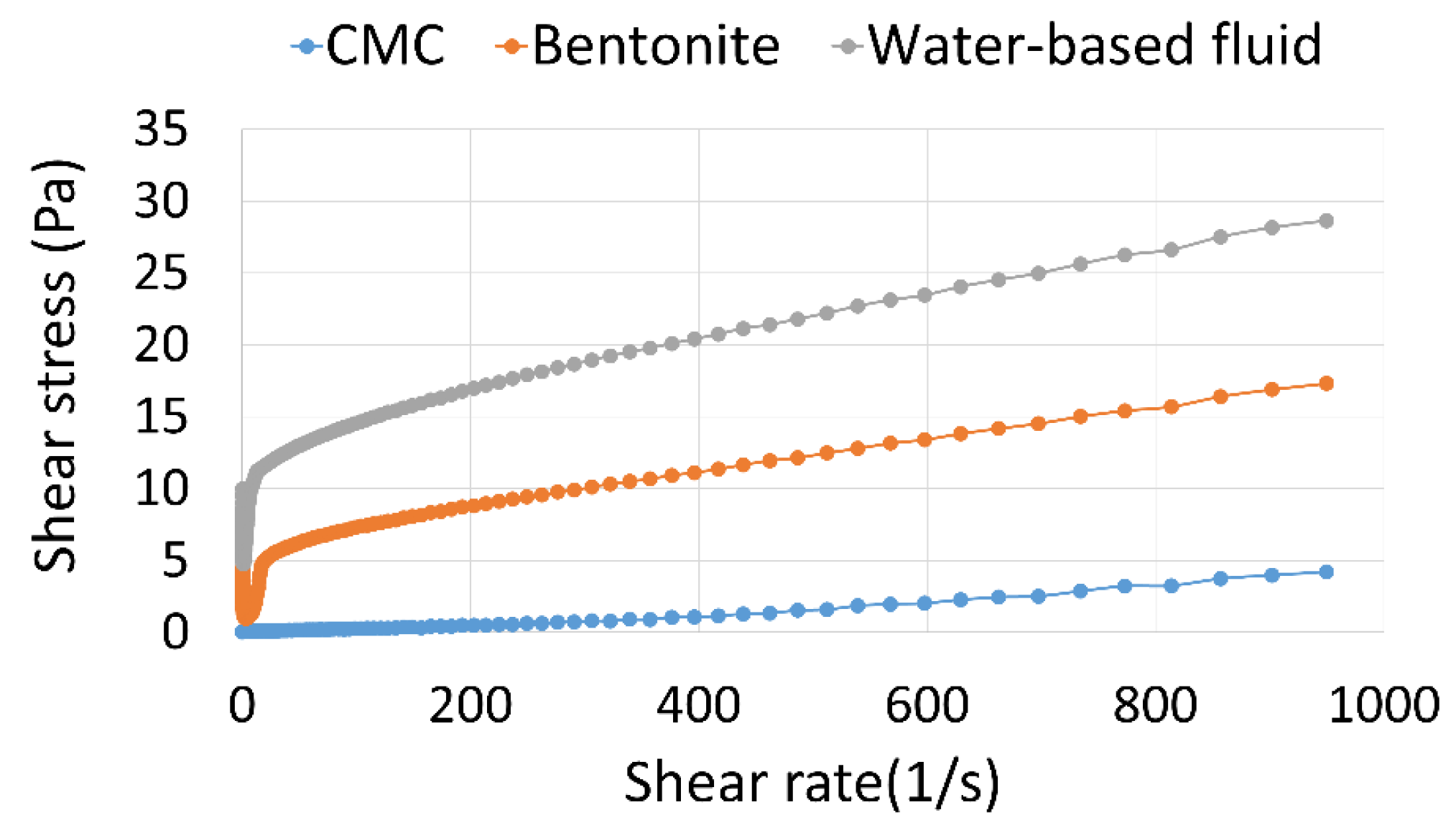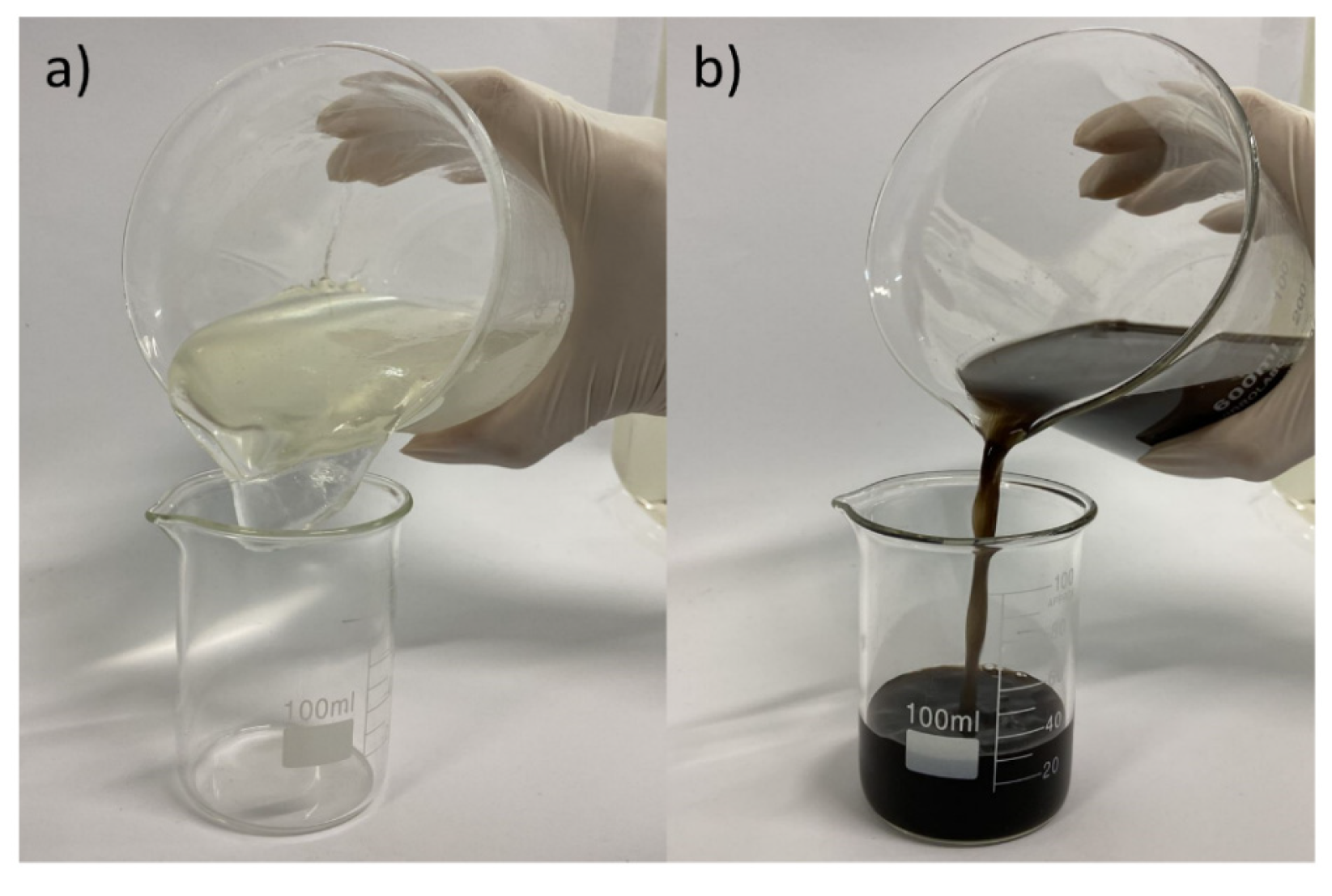3.1. Rheological Behavior
The graphs in
Figure 1 show the flow curves of the water-based fluid, considering the average shear stress values for the samples tested at the same time and temperature conditions.
As observed in the flow curves, the exposure to temperature impacts the rheological behavior of the fluid, resulting in more pronounced reductions in the flow profile for the temperatures of 140 and 150 °C at longer exposure times.
The average values for the rheological parameters and the correlation index (R
2), obtained from the adjustment of the flow curves to the Herschel–Bulkley model, are presented in
Table 3.
The average value of the consistency index at room temperature was 0.44 mPa·s, so failure was recorded for the samples exposed to temperature that showed values lower than that, observed only under the following conditions: 140 °C/7 days (one sample), 140 °C/8 days (one sample), 150 °C/4 days (two samples), and 150 °C/6 days (two samples). As the failure rate was low and only observed at the temperatures of 140 and 150 °C, it can be inferred that the fluid does not present a significant tendency to modify the rheological properties and, consequently, to promotethe sedimentation of solids. This behavior suggests a maintenance of the hydrostatic configuration of the fluid column inside the well during the abandonment operation.
Furthermore, there was a tendency for gradual increases in the average consistency index up to a temperature of 110 °C, with a maximum value of 14.90 mPa·s for the exposure time of 10 days. For 140 and 150 °C, a significant decrease in these values was observed, reaching the minimum average value of 0.81 mPa·s for the condition of 150 °C for 4 days.
This tendency may be related to the behavior assumed by the interactions between bentonite clay particles in the fluid with the increase in temperature. First, at room temperature there was a predominance of dispersed particles. With the increase in temperature to 110 °C, the clay particles tended to flocculate due to face-to-edge interactions, resulting in an increase in viscosity. Finally, the more pronounced increase in temperature, with the exposure of samples to 140 and 150 °C, caused the aggregation of particles due to face-to-face interactions, resulting in the presence of a greater volume of free water in the system and, consequently, reducing viscosity.
Additionally, the reduction in the fluid consistency index with increasing temperature may also be influenced by the degradation of CMC, which guarantees structural rigidity to the system at room temperature [
27] once its degradation in the presence of NaCl can be observed at temperatures close to 150 °C [
28].
The behavior index (
n) presented values below one in all conditions, indicating a maintenance of the pseudoplastic behavior. However, there was a reduction in this with exposure to temperature. At room temperature, the average value of this parameter was 0.78, while a variation from 0.36 (110 °C/10 days) to 0.66 (150 °C/4 days) was observed for samples exposed to temperature. A similar behavior was observed by Ahmad, Kamal, and Al-Harthi (2018) when analyzing the effect of temperature on bentonite clay suspensions added with polymers [
29].
Analyzing the yield stress helps predict the appropriate operational procedure and tension needed for circulating the fluid. This is particularly important when the fluid needs replacement during the abandonment period or for re-entry into the well after temporary abandonment. The results for this rheological parameter also indicate a reduction with the exposure to temperature; however, as observed for the consistency index, a high value of yield stress was observed after exposure to 110 °C for 10 days, possibly related to the high degree of the flocculation of clay particles in this condition. On the other hand, the reductions observed for the higher temperatures were attributed to the significant decrease in the reticulated structure due to high temperatures and high salinity, which impact viscosity and yield strength [
30].
In addition to the variation in the rheological behavior, the effect of increasing temperature on fluid stability is also evidenced by the change in the physical aspect, as shown in
Figure 2, in which a significant supernatant liquid phase is observed for 140 and 150 °C.
The changes in the aspects of the fluid and in the flow profile were compared to the effects of temperature on bentonite clay and CMC, which influence the rheological behavior of the fluid. This was accomplished through saline dispersions/solutions, to which these components were individually added and then exposed to the temperature of 150 °C for 5 days. The results obtained are presented in the flow curves in
Figure 3 and images in
Figure 4 and
Figure 5.
As shown in
Figure 3,
Figure 4 and
Figure 5, the effects of exposure to the temperature of 150 °C after 5 days is much more severe for the CMC solution than for the bentonite clay dispersion. This is noted by a significant reduction in the flow profile, loss of viscous nature, extremely dark color, and characteristic burning smell of the polymeric solution, which highlight the degradation of the polymer. These aspects are similar to those presented by the supernatant aqueous phase of the fluid sample after exposure to higher temperatures. Thus, this comparison suggests that the effect of temperature on the CMC chain was the main agent causing the degradation of the fluid.
The decrease in viscosity of the CMC solutions subjected to temperature was also observed by Zheng, Wu, and Huang (2020), who recorded percentage decreases that ranged from 74 to 94%, depending on the polymer concentration, for temperature increases from 40 to 190 °C [
31]. According to the authors, this phenomenon was due to the fact that increasing the temperature tends to increase molecular activity and reduce the interaction of molecules through hydrogen bonds, which lead to a decrease in the system’s viscosity. Furthermore, it should be noted that the long-time exposure in this study intensified the effects related to this variable and may have also enabled degradation of the polymer chain.
3.2. Filtrate Volume
Table 4 presents the average filtrate volume values for each temperature and time condition.
Based on the results, the fluid presented an average filtrate volume value at room temperature of 8.3 mL. Thus, according to the failure criteria defined for this parameter, which established a maximum increase of 40% of this value, the samples exposed to temperature failed once the filtrate volume exceeded 11.6 mL. For 140 °C, this condition was only observed for the following inspection times: 5 days (one sample), 6 days (three samples), and 7, 8, 9, and 10 days (all samples tested). For 150 °C, failure was observed for the following inspection times: 2 days (one sample), 3 days (one sample), 4 days (five samples), and 6 and 7 days (all samples).
The filtrate volume showed gradual increases with exposure to higher temperatures and longer inspection times, which became more pronounced at temperatures of 140 and 150 °C. As observed for rheological behavior, this increase in filtrate volume may be associated with the progressive thermal degradation of CMC, which acts primarily as a filtration reducer [
32]. Additionally, increases in the temperature and changes in the electrochemical balance may interfere in the degree of flocculation and aggregation of bentonite clay particles, causing changes in the permeability of the mudcake [
33] and resulting in the presence of free water in the system, favoring the filtration of a greater volume of the liquid phase.
Obtaining greater volumes of filtrate directly impacts the hydrostatic configuration of the well, increasing fluid density due to the loss of water from the fluid column to the formation [
34]. Furthermore, a greater volume of the aqueous phase in the formation may be related to the occurrence of damage to the formation, which could impact the reservoir’s production curve. However, significant increases in this parameter were observed only for the temperatures of 140 and 150 °C, which are not usually found. In addition, it is important to note that damage to the formation would only be a concern for wells that are temporarily abandoned with the intention of resuming production activities in the future.
3.3. pH
Table 5 presents the average pH values of the water-based fluid for each temperature and time condition.
The fluid was basic at room temperature, with an average pH of 10.92. For samples exposed to temperature, a reduction in this parameter was observed as the temperature and exposure time increased, exhibiting minimum values for 150 °C after 6 days, whose average value is 7.80.
The decrease in pH, particularly at 140 °C and 150 °C, offers additional evidence of the thermal degradation of CMC. This degradation involves decarboxylation, which produces carbon dioxide (CO
2). The produced CO
2 then forms carbonic acid (H
2CO
3), leading to an increase in hydrogen ions (H
+), which results in the acidification of the aqueous medium [
35]. This reinforces the correlation between the polymer’s degradation and the previously discussed rheological behavior, filtrate volume, and physical characteristics.
To mitigate adverse effects from contaminating electrolytes, minimize corrosion rates, and curb bacterial action on organic components, it is advisable to maintain a weakly alkaline medium with a pH between eight and eleven for fluids containing clay [
36]. However, some samples exhibited a pH below eight after exposure to temperatures of 140 °C for 7 days or more and 150 °C for 5 and 6 days. These conditions align with the failure instances of all samples tested and the highest filtrate volumes, indicating an advanced degradation of the CMC and significant impairment of the formulation.
3.4. Estimation of the Life Characteristics of the Water-Based Fluid
3.4.1. Fluid Failures and Validation of the Statistical Model
Table 6 presents the results of the accelerated life tests regarding the occurrence of failure obtained after testing fluids exposed to temperature, where τ represents the inspection time in days, K is the number of samples tested, and
n is the number of failures observed.
Based on the data in
Table 6, fluid failure occurred only in samples exposed to 140 °C starting on the fifth day of inspection and to 150 °C on the second day of inspection. No failures were observed during inspections at temperatures of 95 °C and 110 °C.
Based on the data set, the following estimates for the model parameters were obtained: s0 = −5.5295, s1 = 1029.2737, and r = 1.9017. The test statistic obtained from these estimates was 0.9038 (with a p-value of 0.6383), indicating that the Weibull model is suitable at the 5% significance level. After the model was validated, the parameter estimates were used to calculate the average lifespan, survival probability, and estimated lifespans for different reliability levels (percentiles).
3.4.2. Average Lifespan
The estimated average lifespans of the fluid for different temperature levels are shown in
Table 7.
According to the estimated average lifespans, the water-based fluid can be used as a barrier element for the maximum time allowed by Brazilian legislation for temporary abandonment without monitoring, which is 3 years [
9], for wells with a downhole temperature of up to 80 °C. For temperatures above 80 °C, where the average lifespan is significantly reduced, the use of the fluid must consider the expected duration of the temporary abandonment and the possibility of periodic monitoring.
The lifespans estimated for the temperatures of 140 °C and 150 °C were compared to failure conditions observed in laboratory tests. At 140 °C, the estimated average lifespan was 5.77 days. In accelerated life tests at this temperature, one failure occurred on the fifth day and three failures on the sixth day. At 150 °C, the estimated average lifespan was 3.54 days. In laboratory tests, a significant number of failures occurred only after the fourth day, with only one failure for the inspections after 2 and 3 days. This comparison shows that the estimated values align with the experimental results and are effective for predicting operational safety related to well maintenance.
3.4.3. Survival Probability
The estimated survival probability, that is, the estimated probability that the water-based fluid survives a given time T (in days) is presented in
Table 8.
Based on the requirements set by Brazilian legislation for well abandonment, it is noted that the probability of the fluid not failing during the maximum allowed time for temporary abandonment without monitoring (3 years—1095 days) is 100% for temperatures of 60 and 70 °C, and greater than 90% for 80 °C.
Downhole temperatures are considered normal up to 80 °C [
37]. Thus, these results demonstrate that the application of the water-based fluid as a well barrier element represents a viable and safe alternative in these conditions, making it possible to considerably reduce operational costs since there is no need to monitor these components until the end of the operation.
If the temperature exceeds 80 °C, it is recommended to use the water-based fluid for operations where the well will be temporarily abandoned for a duration less than the maximum allowed time. For temperatures of 85 °C and 90 °C, operational safety is guaranteed with fluid survival probabilities close to 100% for the time intervals of 1 year (365 days) and 6 months (183 days). However, this probability decreases as the specified time increases, with a significant decline observed especially at a temperature of 90 °C, where the fluid survival probability becomes zero after 1.5 years (548 days).
The application of the water-based fluid is limited by the high probability of failure for operations with an expected duration of more than 6 months for wells where the downhole temperature is greater than 95 °C. In these cases, the operation design must consider shorter operating times, based on the estimated values for the other metrics obtained in this study, with well-defined predictions of re-entry into the well, whether for monitoring, permanent abandonment, or resumption of operations.
3.4.4. Estimated Lifespans According to Reliability Level
Table 9 presents the estimated lifespans of the water-based fluid for each specified temperature, given the reliability level (R(t)).
As observed for the average lifespans of the fluid, there is compatibility between the estimated lifespans and the results obtained in the laboratory. Considering a reliability level of 0.95, for example, lifetimes of 3.97 and 2.43 days were obtained for 140 and 150 °C, respectively, and the first failures at these temperature levels were observed on the fifth and second day of inspection. Thus, this comparison indicates that the survival study carried out is an adequate and satisfactory mechanism for anticipating the failure mechanism and qualifying the fluid as a well barrier element in abandonment operations.
The estimates presented in
Table 5 reaffirm that the application of the water-based fluid in the temporary abandonment of wells is a highly promising alternative, especially for temperatures of up to 70 °C. For these, it is possible to extend the duration of operation to the maximum time allowed, if necessary, since the lifespans are higher than three years (1095 days).
For temperatures above 80 °C, the feasibility of applying this fluid as a barrier element must be guided by factors such as the degree of risk considered acceptable by the operator when planning the operation, the expected operating time, and the possibility of monitoring during the period of abandonment. In these situations, it is necessary to analyze all the estimated service-life characteristics at the predicted downhole temperature. Additionally, for wells with high downhole temperatures where the use of water-based fluid may raise questions about its service-life characteristics, the reliability of the barrier element acting in conjunction with the fluid should be considered in the operational design. These considerations constitute the main limitations to the use of this fluid as a liquid barrier. As a result, its application must be based on technical knowledge and industry best practices, and may also involve the establishment of guidelines and requirements related to monitoring practices to ensure the early detection of potential failure modes.











